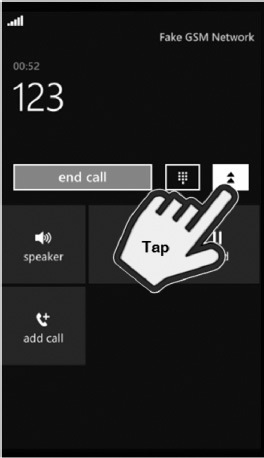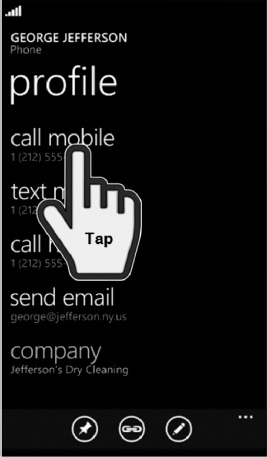Even with a fancy smartphone like your Windows Phone 7 device, sometimes all one needs or wants from a phone is the ability to make a call. This chapter will show you all the different ways you can place a call from your Windows Phone 7 smartphone, including a few smart ways to get connected fast!
Know the number of your favorite pizza place by heart (while ironically not knowing your spouse's)? Dialing a number is a pretty simple affair.
Turn on your phone and unlock it. Then press the Phone live tile. It should be displaying the current cellular network you're connected to (i.e., "AT&T" or "T-Mobile").
A screen similar to that shown in Figure 2-1 will appear, showing by default your call history, or recently called numbers.
Tap the Keypad button at the bottom of the screen to bring up the numeric keypad.
Dial the number you wish to call and press call. If you wish to simply save the number to one of your contacts, you can press the save button. This will launch the contact picker, allowing you to attach it to an existing contact or create a new one—perfect for those times when someone gives you their number and you need to jot it down quickly!
While on the call, the screen shows an end call button

The in-call options let you choose to activate the Speaker phone, Mute your side of the call so that the other party can't hear you sneeze, hold the call, and add calls to the current call—or create a conference call.
When you're done with your call, click end call and the call will be terminated. You'll see that the number you dialed (or name of the person) now appears in the call history.
Tip
If you want to delete your call history, you can do so by pressing the Ellipsis button
Windows Phone 7 allows you to call people from your contacts through a few different ways. The following steps assume you're already in the phone dialer (showing the "call history" screen as shown in Figure 2-1). However, you could also start from the Start screen and press the People live tile. We'll discuss more about this tile in a later chapter.
From the phone screen (Figure 2-1), press the People button. A list of your contacts should appear.
Tap the name of the person you'd like to call (see Figure 2-3).
A screen will appear listing the information you have stored about that person. From here you can tap on the text link to "call mobile" or "call home" (see Figure 2-4).
Tapping the text will cause the phone to dial, and you'll see a screen similar to Figure 2-2, with the same options available to put the call on speaker phone, mute, end, etc.
Windows Phone 7 offers a number of settings (described below) that let you modify how calls are made or received, as well as setting a PIN code required to make a call ("SIM PIN"). To access call settings, from the phone screen (Figure 2-1), press the Ellipsis button and choose "call settings." A screen similar to Figure 2-5 will appear.
My phone number: The first entry on the page displays your phone number—the phone number assigned to the SIM card currently inserted into the device or the phone number programmed into the device by your cellular provider.
Voicemail number:The second number shows your voicemail number. You should not normally have to change this value unless you use a third-party voicemail system other than your cellular provider.
Show my caller ID to: The next setting lets you control who can see your caller ID information when you make a call. The default, "everyone," sends your caller ID information to every caller you dial. You can also tap on the value to change it to "no one" or "my contacts." "No one" tells your phone not to send your caller ID information to any caller you dial. This can be useful if calling someone you do not wish to give your phone number to—they'll see "Unavailable" or "Private" on their screen when your call comes in. "my contacts" is an intermediate option—it sends your caller ID to people you know and have stored in your phone, while not sending it to new numbers you don't have stored in your contact records.
Call forwarding: Call forwarding lets you specify a phone number that all incoming calls to your phone will be redirected to. This setting is stored by your cellular network, so even if you turn off your phone, your calls will still be forwarded until you disable forwarding.
International assist: This setting lets your phone attempt to help you dial international numbers, by ensuring correct formatting so that your call goes through. If you're experiencing issues dialing an international number, you may try switching this off.
SIM security: If your phone has a SIM card, you can use the SIM security settings to configure a PIN number that users must enter to make outgoing calls. This can be useful if others use your phone to look up information but you do not want them making calls. To enable SIM security, tap on the option to slide it to the On position. A screen will appear asking for your SIM PIN number (usually set at 0000 or the last four digits of your phone number by default). Enter the PIN, and you'll see settings similar to those in Figure 2-6. From these settings, you can change your SIM PIN or disable SIM security by tapping on the slider and entering your PIN.
Note
Even with SIM security enabled, your phone can still make emergency calls (e.g., 911) without PIN entry.
Windows Phone 7 can dial phone numbers through other applications as well, (i.e., while finding a location in Maps, or through a person's entry in the People live tile and we'll discuss those throughout this book. In general, your phone tries to determine wherever it sees a group of numbers if it is a phone number, and if so, links it to the phone dialer allowing you to tap and dial instantly. We'll see examples of this as we continue on!






